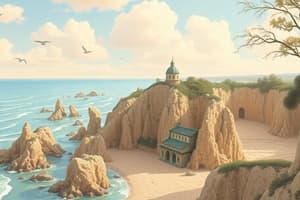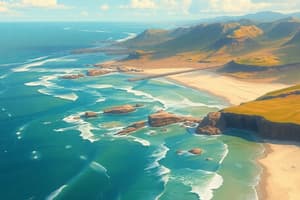Podcast
Questions and Answers
Flashcards
Wave Refraction
Wave Refraction
The bending of a wave crest as different parts of the wave move at different speeds, often due to variations in water depth.
Longshore Current
Longshore Current
A current that runs parallel to the shoreline, transporting sediment along the coast.
Tsunami - Initial Characteristics
Tsunami - Initial Characteristics
A tsunami initially has a small wave height but a very long wavelength, causing a noticeable pull of water away from the shore.
Sandy Coast
Sandy Coast
Signup and view all the flashcards
Rocky Coast
Rocky Coast
Signup and view all the flashcards
Muddy Coast
Muddy Coast
Signup and view all the flashcards
Primary Coast
Primary Coast
Signup and view all the flashcards
Secondary Coast
Secondary Coast
Signup and view all the flashcards
Sea Level Rise
Sea Level Rise
Signup and view all the flashcards
Erosion
Erosion
Signup and view all the flashcards
Literal Zone
Literal Zone
Signup and view all the flashcards
Sediment Budget
Sediment Budget
Signup and view all the flashcards
Hard Protection
Hard Protection
Signup and view all the flashcards
Soft Protection
Soft Protection
Signup and view all the flashcards
Cryosphere
Cryosphere
Signup and view all the flashcards
Earth's Energy Budget
Earth's Energy Budget
Signup and view all the flashcards
Tombolo
Tombolo
Signup and view all the flashcards
Barrier Island
Barrier Island
Signup and view all the flashcards
Barrier Island Rollover
Barrier Island Rollover
Signup and view all the flashcards
Overwash Fan
Overwash Fan
Signup and view all the flashcards
How do Barrier Islands Form?
How do Barrier Islands Form?
Signup and view all the flashcards
Coral Reef
Coral Reef
Signup and view all the flashcards
Gyre
Gyre
Signup and view all the flashcards
Coral Reef Development Stages
Coral Reef Development Stages
Signup and view all the flashcards
Precession
Precession
Signup and view all the flashcards
Glacial-Interglacial Periods
Glacial-Interglacial Periods
Signup and view all the flashcards
Snowline
Snowline
Signup and view all the flashcards
Glacier Mass Balance
Glacier Mass Balance
Signup and view all the flashcards
Glacial Erosion: Plucking
Glacial Erosion: Plucking
Signup and view all the flashcards
Glacial Erosion: Abrasion
Glacial Erosion: Abrasion
Signup and view all the flashcards
Glacial Landforms: Cirque
Glacial Landforms: Cirque
Signup and view all the flashcards
Recessional Moraine
Recessional Moraine
Signup and view all the flashcards
Lateral Moraine
Lateral Moraine
Signup and view all the flashcards
Medial Moraine
Medial Moraine
Signup and view all the flashcards
Glacial Erratic
Glacial Erratic
Signup and view all the flashcards
Esker
Esker
Signup and view all the flashcards
Kettle
Kettle
Signup and view all the flashcards
Active Layer
Active Layer
Signup and view all the flashcards
Study Notes
Wave Refraction
- Waves curve over the peak to form a circle
- Wave parts move in different directions
- Longshore currents run parallel to shorelines
- Beach drift is sediment carried by currents
- Groins show how this sediment moves
Tsunami
- Initial height is small, but length is long
- Water level moves offshore
Coast Types
- Sandy coasts
- Rocky coasts (boulder beaches, cliffs)
- Muddy coasts (silt, clay, tidal flats)
Primary vs. Secondary Coasts
- Primary coasts' features are from terrestrial processes
- Secondary coasts have been changed by marine processes
- Riyas, deltas, and fjords are examples of primary land formation.
Erosional Landforms
- Wave-cut platforms are formed by waves wearing down rock
- Arches are formed by waves carving through headlands
- Stacks are remnants of arches that collapsed
Depositional Landforms
- Beaches are areas where sediment is deposited
- Spits are long ridges of sediment created by longshore transport
- Tombolos connect islands and the mainland by sand
- Barrier islands are parallel to coastlines, separated by water
- Barrier islands' formation is from marine processes
- Salt marshes have peat soil under the surface
Biological Landforms (Coral Reefs)
- Coral reefs are slow-growing organisms that build up
- They are found in warm waters
- They grow throughout many generations
- Flowing water is generally warmer in the northern hemisphere and cooler in the southern hemisphere
Coral Reef Development Stages
- Fringing reefs form near volcanic islands
- Barrier reefs form as islands sink
- Atolls are barrier reefs that continue to grow around a sinking island
Human Impacts on Coasts
- Sea level rise impacts shorelines
- Hard protection structures, like walls, can change sediment movement.
Cryosphere
- Glaciers cover about 10% of the Earth's surface, mostly in Antarctica.
- Snow accumulation forms glaciers
- The cryosphere is made up of ice caps and sea ice.
Glacial Processes
- Glaciers move through internal deformation and basal slip
- Glacial erosion creates U-shaped valleys and other features.
- Glacial drift are sediments from glaciers.
Glacial Landforms
- Moraines are ridges of gravel and rock
- Erratics are large rocks that are transported by glaciers
- Cirques are bowl-shaped depressions at the head of a glacier
- Aretes are sharp ridges between glacial valleys
- Horns are sharp-pointed mountain peaks
Periglacial Environments
- Active layers melt in spring and refreeze in winter
- Frost action creates ice wedges in the ground
- Ice wedges help control soil movement.
Studying That Suits You
Use AI to generate personalized quizzes and flashcards to suit your learning preferences.




